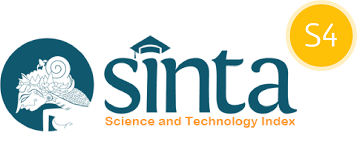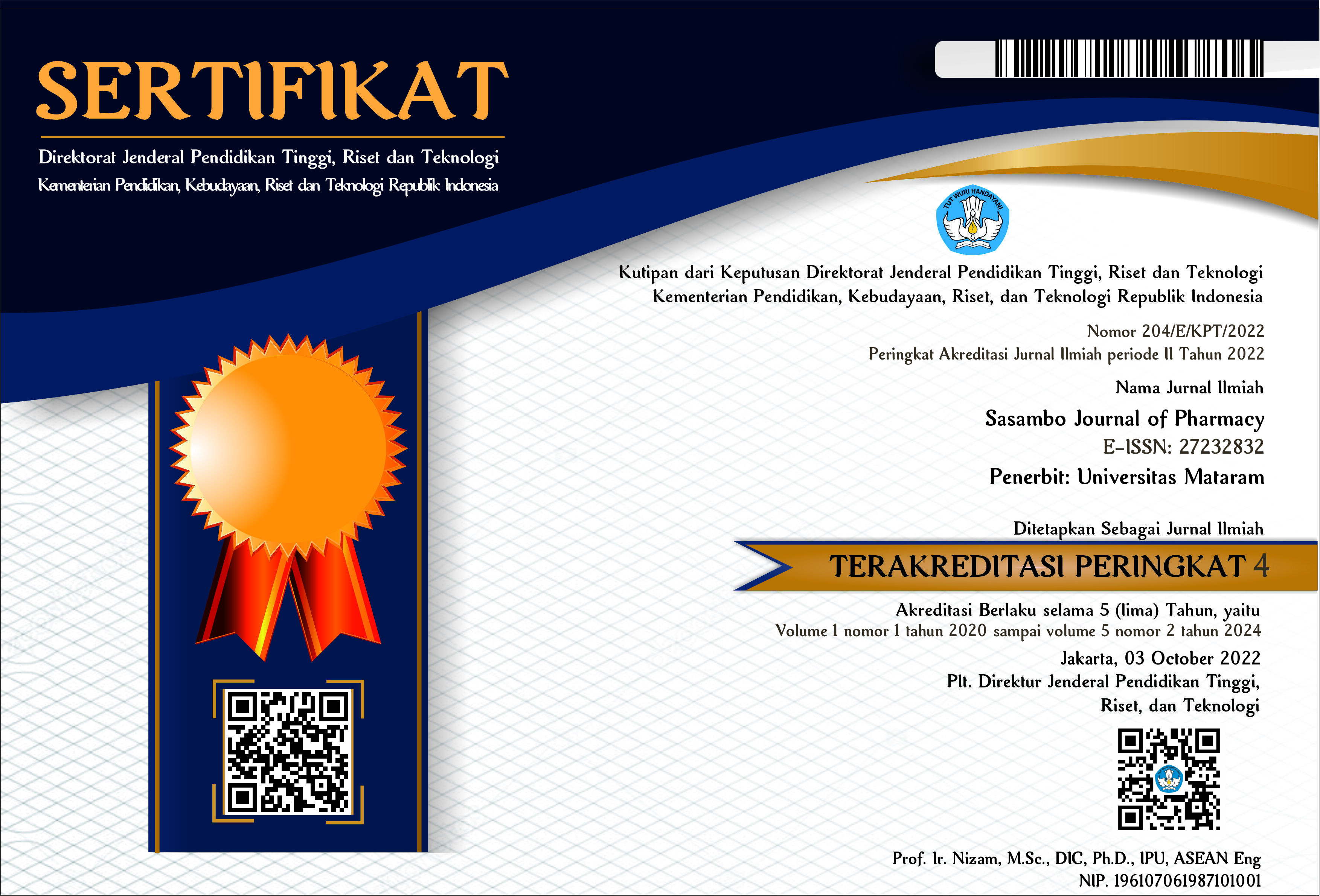Skirining fitokimia ekstrak etanol kulit buah sirsak (Annona muricata Linn) dan uji aktivitas antioksidan dengan metode DPPH
DOI:
10.29303/sjp.v2i2.40Downloads
Abstract
Phytochemical screening research on the ethanol extract of soursop (Annona muricata Linn) peel and antioxidant activity was tested using the DPPH method. The purpose of this study was to determine several classes of compounds found in soursop rind and to determine the antioxidant activity of ethanol extract of soursop rind against DPPH free radicals. The results showed ethanol extract of positive soursop fruit skin containing flavonoids, tannins, and terpenoids. of soursop fruit skin extract was carried out by DPPH method results obtained IC50 value of 192.13 µg / mL ± 5.198137 which was categorized as weak.
Keywords:
Phytochemical screening, Annona muricata Linn., antioxidant activity, DPPHReferences
Andayani, R., Maimunah, M., & Lisawati, Y. (2008). Penentuan aktivitas antioksidan, kadar fenolat total dan likopen pada buah tomat (Solanum lycopersicum L.). Jurnal Sains dan Teknologi Farmasi, 13(1), 31-37. http://repo.unand.ac.id/2221/
Autherhoff, H., & Kovar, K. (2002). Identifikasi obat (N.C. Sugiarso, Trans). Penerbit ITB. (Original work published 1987)
Baskar, R., Rajeswari, V., & Kumar, T. S. (2007). In vitro antioxidant studies in leaves of Annona spesies. Indian J Exp Biol., 45(5), 480-485. https://pubmed.ncbi.nlm.nih.gov/17569293/
Ciulei, J. (1984). Methodology for analysis of vegetables drugs. Bucharest. Faculty of pharmacy Rumania. http://www.download.portal.garuda.org.pdf.
Farsnworth, N. R. (1966). Biological and phytochemical screening of plant. Journal of Pharmaceutical Sciences, 55(3), 225-276. https://jpharmsci.org/article/S0022-3549(15)35305-3/pdf
Hanani, E., Mun’im, A., dan Sekarini, R. (2005). Identifikasi senyawa antioksidan dalam spons Callyspongia sp. dari Kepulauan Seribu. Majalah Ilmu Kefarmasian, 2(3), 127-133. http://journal.ui.ac.id/index.php/mik/article/view/1150/1057
Harborne, J. B. (1987). Metode fitokimia (2nd ed.). Institut Teknologi Bandung.
Hidajat, B. (2005). Penggunaan antioksidan pada anak. Kapita Selekta Ilmu Kesehatan Anak. Jakarta.
Molyneux, P. (2004). The use of the stable free radical diphenylpicrylhydrazyl (DPPH) for estimating antioxidant activity. Songklanakarin J. Sci. Technol., 26(2), 211-219. https://www.thaiscience.info/journals/Article/SONG/10462423.pdf
Muhilal, M. (1991). Teori radikal bebas dalam gizi dan kedokteran. Cermin Dunia Kedokteran, 73, 9-11.
Panagan, A. T., Yohandini, H., & Gultom, J.U. (2011). Analisis kualitatif dan kuantitatif asam lemak tak jenuh omega 3 dari minyak ikan patin (Pangasius pangasius) dengan metoda kromatografi gas. Jurnal Penelitian Sains, 14(4), 38-42. http://ejurnal.mipa.unsri.ac.id/index.php/jps/article/view/204/195
Purwaningsih, S. (2012). Aktivitas antioksidan dan komposisi kimia keong matah merah (Cerithidea obtusa). Indonesian Journal of Marine Sciences, 17(1), 39-48. DOI:10.14710/ik.ijms.17.1.39-48
Wijaya, A. (1996). Radikal bebas dan parameter status antioksidan. Prodia Diagnostic Educational Services. Jakarta.
Zuhra, C. F., Tarigan, J. B., & Sihotang, H. M. (2010). Aktivitas antioksidan senyawa flavonoid dari daun katuk (Sauropus androgunus (L) Merr.). Jurnal Biologi Sumatera, 3(1), 7-10. https://www.semanticscholar.org/paper/Aktivitas-Antioksidan-Senyawa-Flavonoid-Dari-Daun-Zuhra-Tarigan/80dce8da8d62d16864af019784c8610e4034c972
License
Authors who publish with Sasambo Journal of Pharmacy (SJP), agree to the following terms:
- Authors retain copyright and grant the journal right of first publication with the work simultaneously licensed under a Lisensi Creative Commons Atribusi 4.0 Internasional. This license allows authors to use all articles, data sets, graphics and appendices in data mining applications, search engines, web sites, blogs, and other platforms by providing an appropriate reference. The journal allows the author(s) to hold the copyright without restrictions and will retain publishing rights without restrictions.
- Authors are able to enter into separate, additional contractual arrangements for the non-exclusive distribution of the journal's published version of the work (e.g., post it to an institutional repository or publish it in a book), with an acknowledgment of its initial publication in Sasambo Journal of Pharmacy
- Authors are permitted and encouraged to post their work online (e.g., in institutional repositories or on their website) prior to and during the submission process, as it can lead to productive exchanges, as well as earlier and greater citation of published work (See The Effect of Open Access).







